AI Coaching Tools for Gamers: Elevate Your Game in 2025
Updated On: August 23, 2025 by Aaron Connolly
What Are AI Coaching Tools for Gamers?
AI coaching tools act like digital assistants for gamers. They break down your gameplay and give you feedback in real time, pushing you to improve faster than you might with old-school practice.
These systems run on advanced algorithms that spot patterns in your play—stuff a human coach could easily overlook. You get training recommendations tailored to you, and they’re available whenever you want, day or night.
Defining AI Coaching in Gaming
AI coaching tools are software platforms that dig into your gameplay data and spit out feedback that actually makes sense for you. They gather info from your matches, like how accurate your aim is, how fast you react, your positioning, and even how you make decisions.
Under the hood, these tools rely on machine learning. They compare your stats to huge databases packed with pro player data and winning strategies. That way, they can point out where you’re falling short.
Platforms like trophi.ai and GCoach.AI crunch thousands of data points from every session. They keep an eye on everything from your mouse movements to the choices you make under pressure.
But they don’t stop at just collecting numbers—they turn all that info into advice you can actually use. Maybe the AI coach notices you always miss shots when moving left. It’ll suggest aim training exercises just for that.
A lot of these systems plug right into your favorite games. You get feedback on the spot, not hours later after uploading a replay.
How AI Coaches Differ from Traditional Coaching
Traditional coaches work with you during set sessions and give feedback based on what they see. AI coaches keep tabs on you all the time, tracking stuff humans just can’t process at the same speed or volume.
Human coaches really shine when it comes to reading your mindset and team dynamics. They can boost your morale and break down tough strategies in a way that clicks.
AI coaches, though, process up to 50,000 data points per match—that’s wild. No human’s keeping up with that, or spotting every tiny thing you do.
Cost is a big deal too:
- Human coaching: £30-100+ an hour
- AI coaching platforms: £10-30 a month
- Some basic AI tools: Free, but you’ll pay for premium features
You can fire up an AI coach any time you want. Human coaches? Not so much. Their time is limited, and frequent sessions add up fast.
Still, AI coaches aren’t perfect. They sometimes miss the context—maybe they’ll suggest a strategy that usually works, but it just doesn’t fit your team or your style.
Key Benefits for Modern Gamers
Instant feedback stands out as the biggest perk. You don’t have to wait for your next session; you get the analysis right away and can fix things on the fly.
AI coaches build personalised training plans around your weak spots. If your reaction time sucks, you’ll get drills that actually help with that.
They’re great at tracking your progress too. You’ll see exactly how you’re improving, broken down by game mode or skill.
Accessibility is a game changer, especially if you live somewhere remote or don’t want to drop loads of cash. No need to hunt for a coach nearby or pay crazy hourly rates.
A lot of these tools offer cross-game analysis. So, if you get better at aiming in one game, you’ll see those skills carry over to others.
The tech gives you objective feedback—no sugarcoating. Human coaches might gloss over certain mistakes, but AI lays it all out, good and bad.
If you play competitively, some AI coaches can even scan your opponents’ patterns and suggest counter-strats based on thousands of similar games.
Core Features of Leading AI Coaching Tools
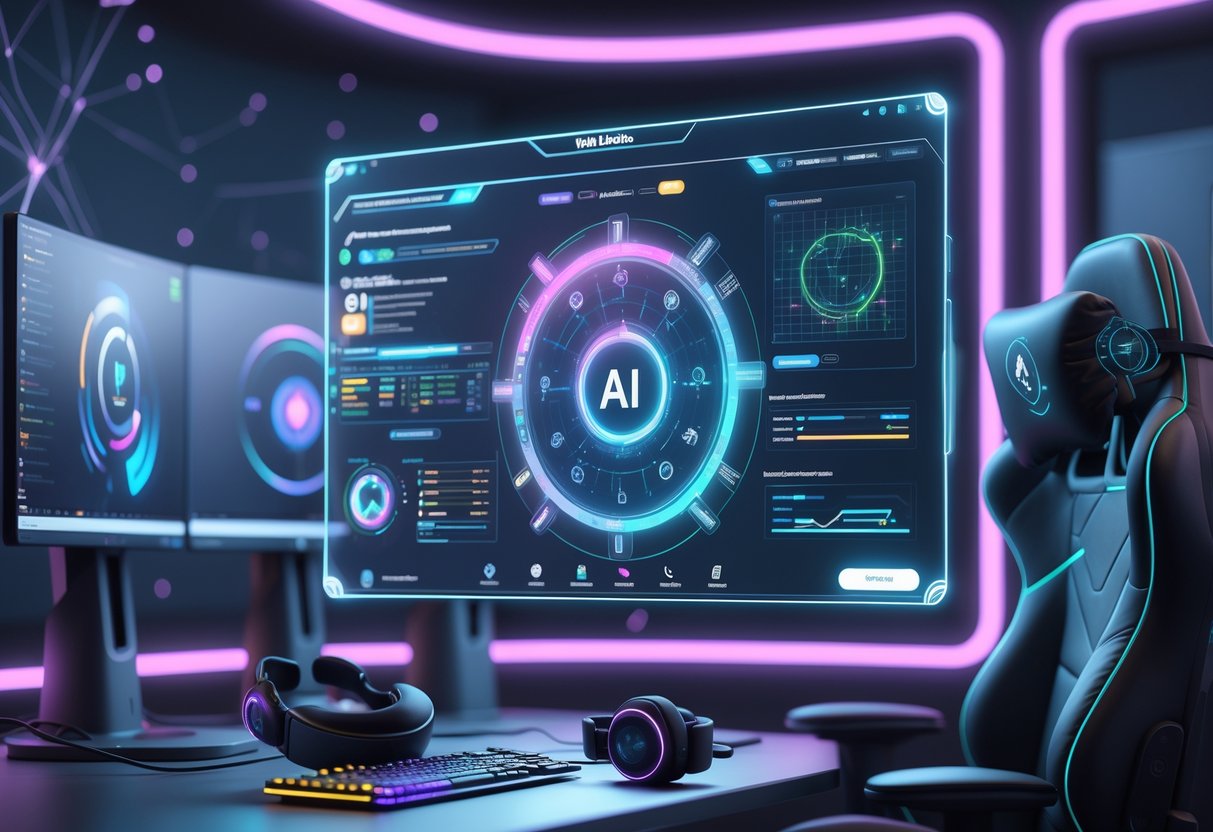
AI coaching platforms come packed with features you won’t find in traditional training. They blend real-time analysis with personalised learning systems so you can level up faster.
Personalised Feedback and Progress Tracking
The best AI coaches really dig into how you play and give feedback that’s actually useful. Instead of tossing out generic tips, they track your habits and mistakes.
iTero for League of Legends, for example, serves up over 500 stats tailored to your champion pool and skill level. It’ll point out patterns in your losses and show exactly where you’re slipping up.
Modern AI coaching tools build out performance profiles that grow with you. They track stuff like:
- Accuracy rates for your weapons or skills
- Decision-making under pressure
- Positioning errors that get you killed or waste opportunities
- Resource management over time
Omnic.AI goes a step further and auto-generates highlight videos. You can watch your best moments and biggest blunders, which feels way more engaging than staring at a spreadsheet.
Progress tracking isn’t just about numbers. These tools show how you’re improving week by week, which can keep you motivated.
Adaptive Learning Algorithms
AI coaching tools get smarter the more you play. They tweak their advice as your skills change.
Microsoft’s Xbox Copilot is a good example. In Overwatch 2, it learns which heroes you prefer and suggests picks that fit your team and your play history.
The algorithms keep updating as you improve. That beginner tip you got at bronze? The system swaps it out for advanced strats once you climb to gold or platinum.
They even adjust to meta changes. When a game drops a new patch or character, the AI coach updates its advice to fit the latest trends.
Quick tip: Pick AI coaches that update their databases often. Outdated advice can actually trip you up in fast-paced games like Valorant or Fortnite.
Game-Specific Training Modules
Top AI coaching platforms don’t try to cover every game out there. Instead, they go deep on a few and build specialised training tools.
Osirion is all about Fortnite. It’s got features like Hypermap, which shows you heatmaps of your landing spots and loot routes. You won’t get that kind of detail in a generic app.
Trophi.ai gets even more niche. It’s built just for sim racing, with Mansell AI giving you real-time voice coaching while you drive. It looks at telemetry data and gives you instant feedback on your racing lines and braking.
Game-specific modules usually include:
| Feature Type | Examples |
|---|---|
| Aim Training | Crosshair placement drills, flick shot practice |
| Strategy Analysis | Map control patterns, rotation timing |
| Character/Weapon Guides | Ability combos, damage optimisation |
| Situational Training | Clutch scenarios, team fight positioning |
Squid Academy takes a layered approach. It starts you off with basic stats and then moves you into more advanced AI-powered modules as you level up. That way, you don’t get overwhelmed right away.
The best AI coaches focus on one or two games and go deep, instead of spreading themselves thin.
How AI Coaches Work: Technology and Mechanics
AI coaching systems mix advanced data crunching, real-time game analysis, and machine learning to give you feedback while you play. They use computer vision to watch your screen, break down thousands of data points, and serve up tips based on what works for top players.
Data Analysis and Pattern Recognition
AI coaches sift through a mountain of gaming data to spot patterns in how you play. They log every mouse click, keyboard tap, and move you make.
The system tracks things like your reaction time, accuracy, positioning, and how quickly you make decisions. It then compares your stats to databases with millions of matches from players at every skill level.
Key data points:
- Shot accuracy and timing
- Map positioning and movement
- Resource management choices
- Team coordination
Modern AI coaches can break down up to 50,000 data points from a single match. They’ll catch mistakes you keep making, like always being out of position or moving in predictable ways.
The more you play, the better these pattern recognition algorithms get at understanding your unique style. Their tips get more accurate as they learn your habits.
Vision and Speech Recognition in Gameplay
Computer vision lets AI coaches “see” your screen in real time, almost like a coach sitting next to you. The system snaps screenshots every second and figures out what’s happening in your game.
Speech recognition adds another layer. Some AI coaches listen in on your team comms and can even take voice commands, so you don’t have to pause to ask for advice.
Vision features:
- Enemy position spotting
- Health and resource tracking
- Map awareness
- Inventory checks
Razer’s Project AVA is a good example. It looks at your screen mid-match and gives you advice, like when to push or when to back off.
This visual analysis happens in milliseconds, so you get advice right when you need it. That’s huge for making better calls in the heat of battle.
Machine Learning and Real-Time Recommendations
Machine learning drives the recommendation engine behind these coaches. The systems study pro strategies and adapt their tips to your skill and what’s happening in your game.
The AI processes your live data, matches it to winning strategies from the pros, and turns that into advice you can use—through voice, text, or on-screen overlays.
Real-time features:
- Tactical advice on the fly
- Warnings for risky situations
- Positioning tips
- Counter-strategy suggestions
Platforms like Aimlabs use machine learning to build custom training routines. They spot your weak points and create drills just for you.
As you get better, the recommendations change to keep you challenged. Some advanced systems even predict what your opponents will do and help you counter them before things happen.
Popular AI Coaching Platforms and Applications
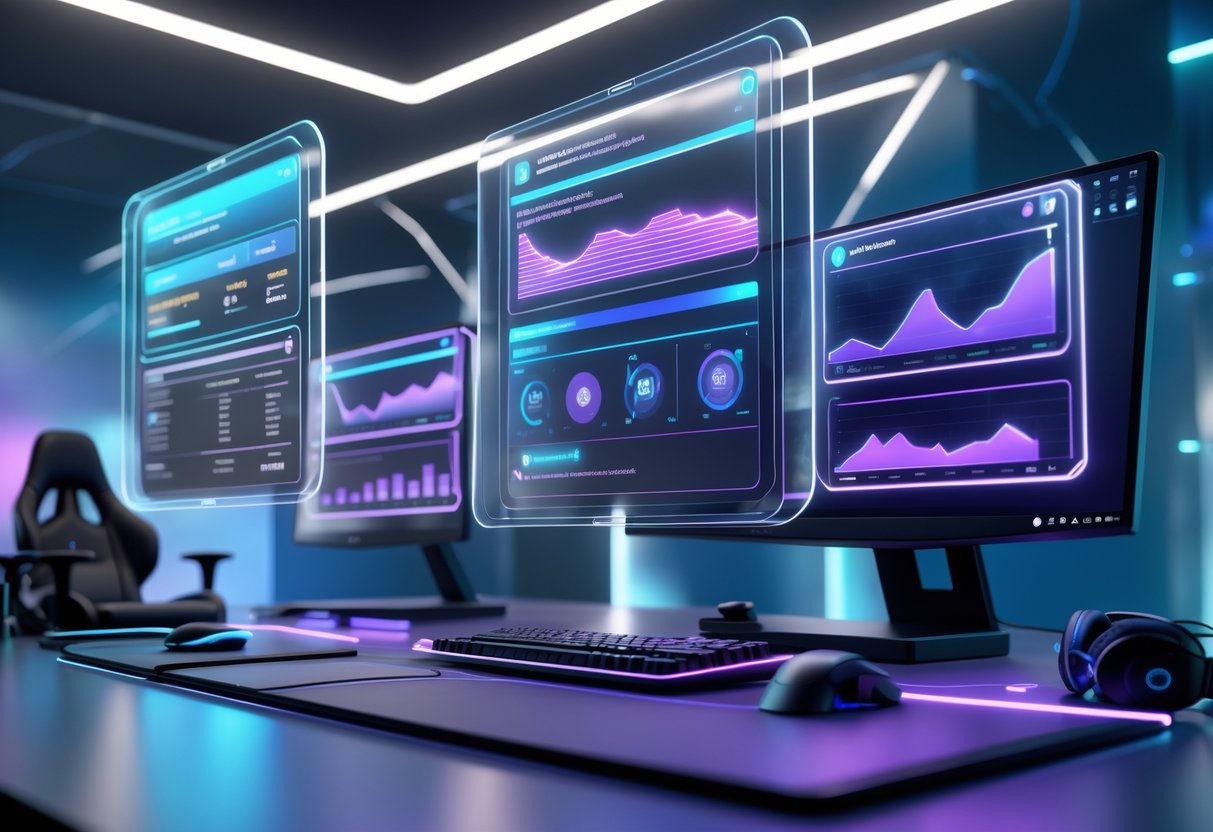
A bunch of specialised platforms have popped up, giving gamers smart coaching through real-time feedback and performance analysis. These range from deep-dive analysis systems to new AI companions that learn your style.
Overview of Backseat AI
Backseat AI acts as a gaming companion that coaches you in real time while you play. It watches your performance live and drops strategic suggestions without wrecking your focus.
The AI looks at your decision-making patterns and matches them to pro-level plays. You’ll get feedback through subtle audio hints or text overlays that don’t pull you out of the game.
Key Features:
- Real-time strategy advice
- Pattern recognition for repeated mistakes
- Pro gameplay comparisons
- Adjustable feedback intensity
Most players start seeing improvement in their first week. The system learns how you play and dials back the basics, shifting to more advanced tactical tips as you progress.
GCoach.AI and Trophi.ai Capabilities
GCoach.AI is all about video analysis for gamers and streamers. You upload your gameplay and get detailed breakdowns of key moments, missed chances, and clutch plays.
It uses multi-modal analysis—so it checks audio, video, and gameplay data at the same time. You’ll get insights on clutch moves, positioning slip-ups, and timing mistakes that a human coach might overlook.
GCoach.AI Analysis Features:
- Frame-by-frame gameplay breakdown
- Audio cue detection
- Highlight reel creation
- Performance comparison with pros
Trophi.ai targets competitive rank improvement with personalised training modules. The AI builds practice routines around your weakest areas.
Both platforms offer free basic analysis, with premium features starting at about £15 a month. A lot of pro streamers use these tools to make educational content for their viewers.
Emerging Tools: Project AVA and Solvyn
Project AVA is pushing AI coaching into the future with advanced natural language processing. This gaming companion chats with you about strategy and tosses out contextual advice as the meta shifts.
It keeps an eye on pro tournament trends and updates its recommendations in real time. You can fire off questions about matchups, item builds, or tactics right in the middle of a game.
Solvyn heads in a different direction, zeroing in on mechanical skill development. The AI coach builds aim training routines and movement exercises just for you, based on your own stats.
Emerging Features Include:
- Voice-activated coaching requests
- Meta-analysis integration
- Cross-game skill transfer
- Predictive performance modelling
These platforms are still in beta, so only a few folks can get in right now. Early access usually runs £25-40 a month, but public releases should come with cheaper options soon.
In-Game Overlays and On-Screen Assistance
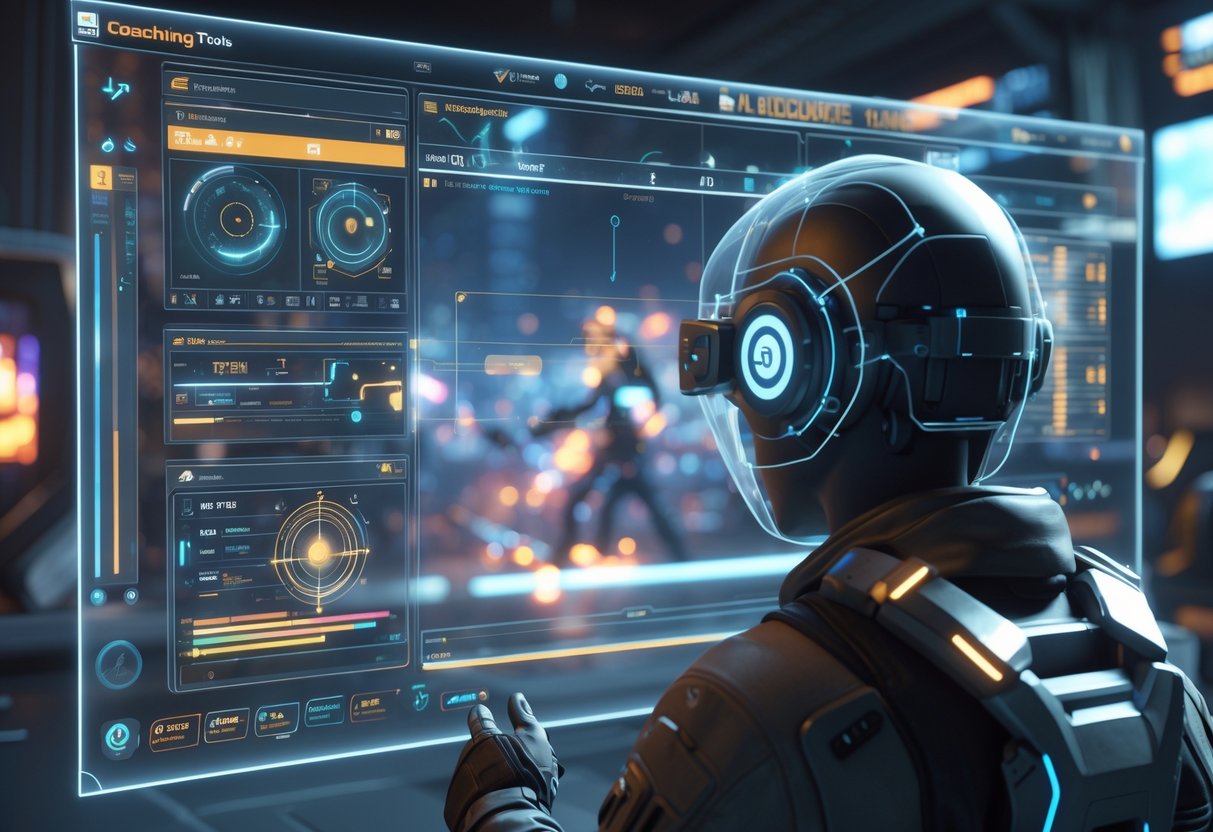
Modern AI coaching tools now slip right into your games with smart overlays and voice systems. You get real-time tips without needing to pause or alt-tab.
Benefits of In-Game Overlays
An in-game overlay puts coaching info right on your screen as you play. That means you get feedback instantly, so your focus stays sharp.
Most AI coaches keep stats tucked into small windows at the screen’s edge. You’ll spot your accuracy, suggested moves, or enemy patterns updating as the match unfolds.
Project AVA by Razer stands out with a super advanced overlay system. It watches your gameplay with vision tech and throws out coaching tips on the fly.
It runs through millions of game simulations to offer the best advice for whatever’s happening.
Key overlay features include:
- Live performance tracking
- Strategic recommendations
- Enemy behaviour analysis
- Equipment optimisation suggestions
- Post-match replay highlights
The big perk? Seamless learning. You won’t have to watch separate training videos or dig through guides. The coaching just happens while you play.
Voice Assistants and Chatbox Support
Your AI coach can talk right through your headset or pop up in a chat window. Voice assistants let you ask for help mid-game without lifting a finger. Just say, “What should I buy next?” or “How do I beat this comp?”
Some folks prefer chatbots for quieter sessions. You can type out questions between rounds or during loading screens—handy if you’re already chatting with teammates.
Popular communication methods:
- Voice commands through headset
- Text chat in a separate window
- Quick hotkey responses
- Audio coaching during gameplay
GCoach.AI and PlaySync both let you pick voice or text. You can swap methods anytime, depending on what works best for you.
That flexibility means you get help right when you need it. No more pausing to Google guides or slogging through long tutorials.
Non-Intrusive Gaming Companions
The best AI coaching tools act like quiet gaming companions—not annoying overlays. They give you helpful info but stay out of the way during clutch moments.
Smart systems figure out when to chime in and when to hold back. If you’re in a firefight, they’ll wait. If you’re in a planning phase, they might offer a suggestion.
Non-intrusive features:
- Contextual timing for tips
- Minimal screen space usage
- Optional audio cues
- Customisable display settings
Omnic.AI and trophi.ai focus on background analysis. They watch your games and save insights for later, so you can stay immersed and review coaching data when you’re ready.
You call the shots on how much help you want. Tweak settings to show more or fewer tips, depending on your skill level or mood.
Real-Time Feedback and Live Coaching
AI coaches now give instant guidance as you play, catching mistakes live and tossing out better strategies on the spot. Platforms use voice commands and overlays to coach you without messing up your flow.
Instant Strategy Adjustments
Real-time AI coaching changes how fast you can adapt mid-match. The AI coach sees what’s happening and suggests tactical tweaks through audio cues or in-game overlay popups.
In racing games, Trophi.ai calls out braking points and racing lines while you drive. If you’re cornering too hard, it’ll tell you to ease up right away.
For shooters, AI coaches track your positioning and suggest safer angles or aggressive pushes based on enemy moves. This all happens in seconds, not after the game ends.
Quick win: Try audio-only coaching first if you want to avoid clutter on your screen.
The tech compares your live gameplay to millions of pro data points. When it spots a better way to play, you’ll hear a short, clear tip.
Mistake Identification and Correction
AI coaching is great at catching errors you probably miss in the heat of the moment. It flags things like bad resource use, poor positioning, or missed timings as they happen.
In-game overlays highlight exactly where you slipped up. Maybe a red marker shows where you should’ve stood, while audio feedback explains why.
This process focuses on immediate learning, not endless post-game analysis. If you mess up a key combo, the AI tells you the right sequence right away.
Warning: Too much feedback at once can be a lot for beginners. Start by focusing on one coaching area.
Most platforms let you pick which mistakes trigger alerts. You can work on mechanics during practice, then add strategic feedback when you’re ready for ranked matches.
Post-Game Analysis and Performance Tracking
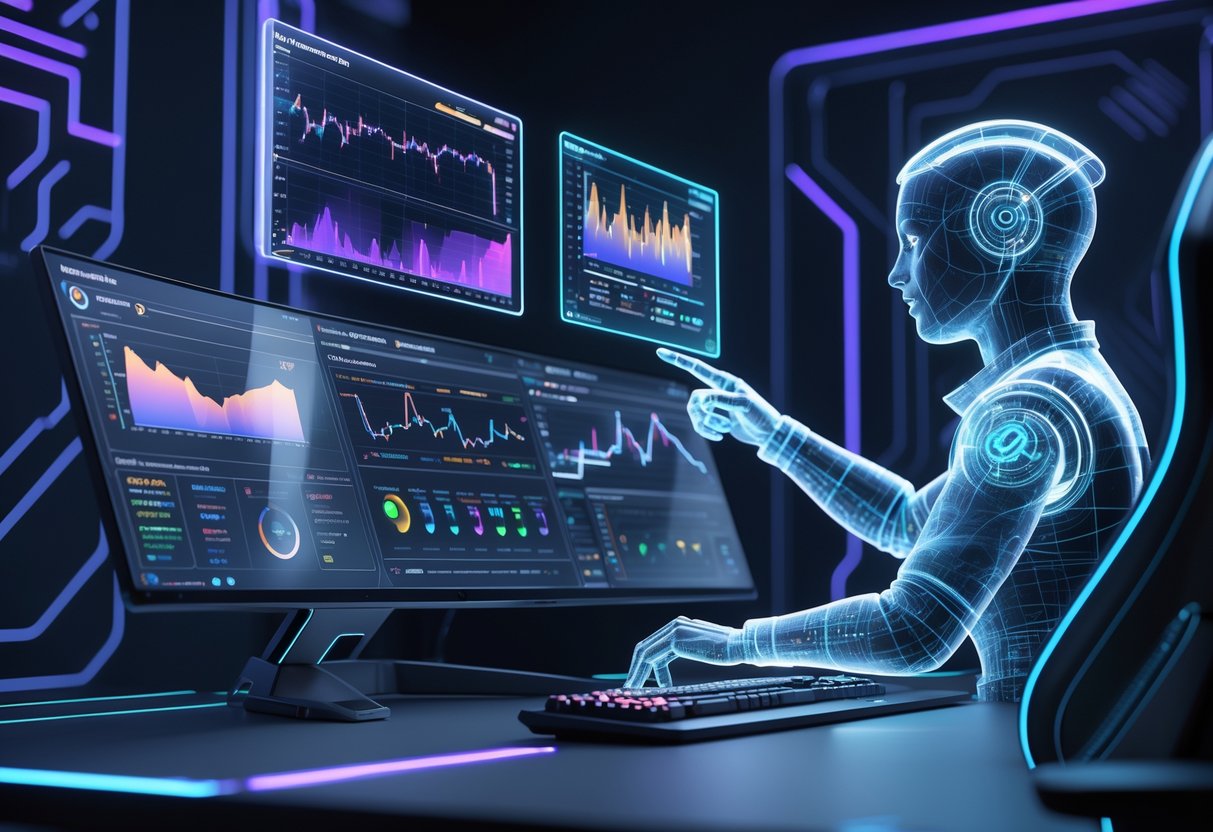
Modern AI coaching platforms break down your matches and build performance reports automatically. They track your progress and create training plans tailored to your weaknesses.
Personalised Post-Match Reports
AI coaches dig into every part of your gameplay after each session. They track stuff like positioning, decisions, reaction speed, and accuracy in different situations.
Key Performance Areas Tracked:
- Mechanical skills – Aim precision, movement patterns, ability usage
- Strategic decisions – Map rotations, resource management, team coordination
- Timing patterns – Reaction speeds, combo execution, defensive responses
- Consistency metrics – Performance variation across different match phases
The AI compares your current performance to older games. It points out where you nailed it or where things fell apart.
Platforms like GCoach.AI and Regression.gg break down big moments with timestamps and visuals. They highlight your clutch plays and missed chances.
These reports give you a sense of your rank progression. They estimate how long it might take to move up based on your current improvement rate.
Learning Paths and Training Plans
AI coaching tools build custom training schedules from your performance data. They target your biggest gaps first and ramp up the challenge as you get better.
Training Plan Components:
- Skill-specific drills – Aim trainers, positioning exercises, reaction challenges
- Time allocation – Recommended practice duration per skill area
- Progress milestones – Clear goals with measurable targets
- Difficulty scaling – Automatic adjustment as you improve
The AI sets up different practice types each week. It mixes mechanical drills, strategy sessions, and live games.
Platforms like Omnic.AI keep tabs on your improvement over months. If you hit a wall or suddenly start excelling, the plan shifts to match.
Most AI coaches suggest spending 20-30% of your gaming time on focused practice. The rest is for applying what you’ve learned in real matches, with the AI still watching and analyzing.
Customisation and Skill Adaptation

Modern AI coaching platforms tweak their teaching to fit your strengths, weaknesses, and gaming style. They analyze your stats to build training programs that grow with you, even as you switch genres.
Tailoring AI Advice to Individual Players
AI coaches pull data from your matches to see how you play. They track reaction times, choices, and go-to strategies.
This info builds a unique player profile. The AI learns if you’re aggressive, defensive, quick, or methodical.
Based on that, you’ll get specific advice. If you struggle with aim, you get aim tips. If you need better positioning, you get those instead.
PlaySync and GamerSense crunch thousands of data points per match. They notice if you panic under pressure or clutch up when it counts.
The AI even adjusts how it teaches. Some players want visuals, others need step-by-step instructions.
Your improvement speed matters too. Beginners get simple basics, while advanced players get next-level tactics.
Supporting Different Game Genres
Every game genre calls for different skills. FPS games are all about aim and positioning, while MOBAs lean on teamwork and timing.
AI coaches know the difference. They switch up their advice when you jump from Counter-Strike to League of Legends.
| Genre | Key Skills | AI Focus |
|---|---|---|
| FPS | Aim, positioning, map awareness | Crosshair placement, angle holding |
| MOBA | Last-hitting, team fights, objectives | Farming patterns, ward placement |
| Battle Royale | Survival, looting, positioning | Zone management, engagement timing |
Aim Lab specializes in FPS training with drills that match your favorite shooter.
Faceit Nexus tweaks matchmaking and coaching based on your chosen game. It knows that CS2 skills don’t always work in Valorant.
Some platforms analyze skills across genres, spotting abilities like quick reactions or smart strategy that carry over.
Adaptive Training Plans
Your training plan isn’t static—it shifts as you grow. The AI coach bumps up the difficulty and adds new ideas over time.
You’ll start with an assessment to find your level. Maybe you’ll spend a few weeks on basic aim before moving up.
Progress tracking keeps your plan fresh. If you stall in one area, the AI adds focused sessions to help.
Weekly goals keep you motivated. The coach picks targets that fit your available practice time.
Training intensity changes with your schedule. If you’re a casual player, you’ll get shorter, focused sessions. If you’re grinding, expect tougher programs.
The system notices your learning patterns too. If you improve faster on weekends, it’ll schedule tougher stuff then.
Quick win: Most AI coaches offer free skill checks. Try trophi.ai or GCoach.AI to see adaptive training in action.
System Compatibility and Platform Integration

AI coaching tools work across different setups, but compatibility really depends on the platform. Most modern gaming companions play nice with Windows and Mac, though mobile features are still pretty limited.
Supported Operating Systems
Windows is still the go-to for AI gaming coaches. Tools like PlaySync and GCoach.AI focus on Windows 10 and 11, giving you real-time analysis and smooth integration with the big gaming platforms.
Mac users get fewer options. Basic features usually work, but advanced analysis can lag. Some tools offer web versions that get around OS limits.
Mobile is the trickiest. iOS and Android apps usually only give you simplified versions of desktop tools. You can check stats and get tips, but live coaching while you play is rare.
Linux users need to check compatibility closely. Not many AI coaches support Linux natively, though a few work through browser interfaces or compatibility layers.
Game Compatibility and Updates
AI coaching tools really focus on the biggest competitive games out there. League of Legends, CS, Valorant, and Rocket League get the most attention. These titles have deep data APIs, so coaching tools can dig into your stats.
When a new game drops, developers need a few months to add decent AI coaching support. Usually, you’ll wait about 3-6 months before AI coaches feel reliable. Sometimes there’s a beta option earlier, but it’s usually missing key features.
Warning: AI tools often struggle when games update. Big patches can break things for a while, and you might lose coaching features right when you need them most.
Cloud-based tools tend to handle updates better than stuff you install locally. They update on their end, so you don’t have to mess with downloads.
Integration with Existing Gaming Setups
Most AI coaches use overlay systems like Discord or Steam overlays. They show info on top of your game without slowing things down. You’ll spot little widgets with tips or performance stats.
Hardware needs can be all over the place. Simple coaching is light, but real-time video analysis? That wants a beefy GPU. Always check what specs you’ll need before paying for a subscription.
Streaming compatibility is a big deal for content creators. Tools like Trophi.ai and Microsoft’s Copilot play nice with OBS and similar software. Some even have streamer modes that let your viewers see coaching info.
If you have more than one monitor, you’ll get the most out of AI coaching tools. Put your game on one screen and keep coaching insights handy on another.
Safety, Compliance, and Fair Play Considerations
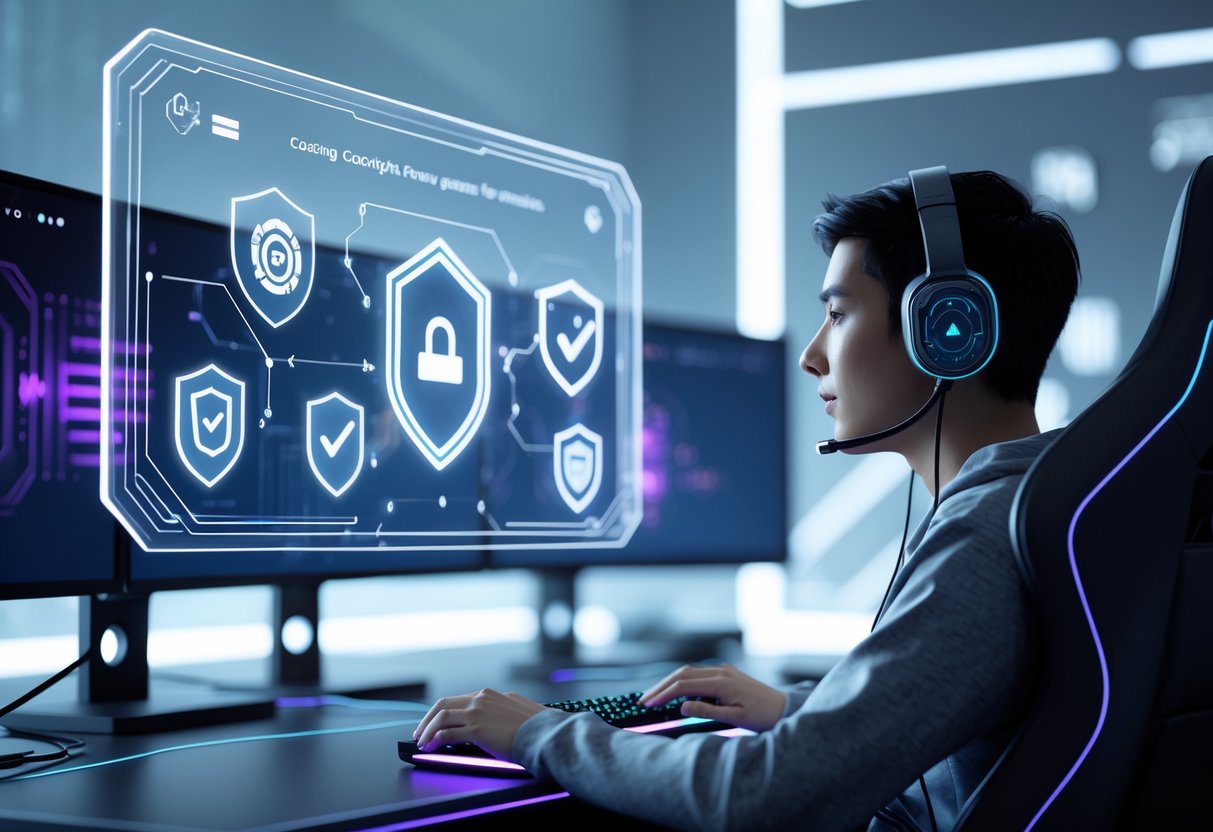
AI coaching tools need to follow strict ethical rules to keep games fair. Data protection and anti-cheat measures matter a lot if you want players to trust these tools in competitive settings.
Avoiding Cheating and Violations
AI coaching systems always walk a tricky line between helping and giving unfair advantages. Gaming platforms keep getting better at spotting weird patterns or automated help.
Legit coaching features include replay reviews, tracking your stats, and suggesting strategies based on how you play. These help you improve without giving you in-game advantages.
Prohibited stuff? Anything that takes control, gives you live info about opponents, or automates your actions. Games like Counter-Strike 2 and Valorant will ban you fast if you use software like that.
Game companies pour resources into anti-cheat technology. Riot’s Vanguard and Valve’s VAC catch cheaters—and they spot dodgy AI tools within minutes.
Warning: If you use unauthorized AI help, you risk losing your account and everything you’ve bought. Sometimes, that’s hundreds of pounds gone in a second.
Pro esports teams enforce strict rules. If officials catch players using banned AI, they get kicked from tournaments and can wreck their careers.
Timing and scope make all the difference. Post-match analysis tools are fine, but anything that helps you mid-game usually breaks the rules.
Data Privacy and User Security
AI coaching platforms collect a ton of data—your gameplay, chat logs, and stats. UK GDPR rules require careful handling of all that info.
Key security measures include encrypted data transfers, secure cloud storage, and short retention times. Good coaching services clearly explain what they collect and how long they keep it.
Many platforms ask to connect with your gaming accounts, Discord, or streaming tools. Always double-check permissions before you let third-party apps in.
Biggest privacy risks? Data leaks that expose your stats, insecurely stored account details, or companies selling your info to advertisers.
Look for services with local data processing. These analyze your gameplay on your own device, so nothing sensitive leaves your PC.
Young gamers are especially at risk. Parents should check out any AI coaching tool their kids want to use, especially if it asks for account links or personal data.
Quick tip: Turn on two-factor authentication before connecting AI coaching software. Even if someone gets your login, they can’t get in.
Future Trends in AI Gaming Coaching
AI coaching keeps getting smarter, aiming for real-time feedback and instant analysis. Gaming communities now play a big part in shaping these tools, giving feedback that actually changes how they develop.
Features like voice-guided help and cross-platform support are making AI coaches easier to use than traditional human coaching.
Upcoming Technologies and Features
Voice-Guided Coaching is the next big thing. Trophi.ai already gives real-time voice feedback during sim racing. By 2026, you’ll probably see this in every major esport.
Cross-Platform Integration is coming fast. Microsoft’s Xbox Copilot lets your AI coach follow you from console to mobile app. Soon, you’ll get coaching whether you’re on PC, console, or your phone.
Advanced Real-Time Analysis goes way beyond tracking stats. Modern AI now studies your decisions and predicts better strategies while you play. Soon, you’ll get:
- Predictive opponent analysis live in matches
- Team comp suggestions based on what’s strong in the meta
- Mistake warnings before you mess up
Virtual Reality Coaching is on the horizon, too. AI will walk you through 3D practice, letting you repeat tricky scenarios until you nail them.
Community Feedback and User Insights
Player-Driven Development is taking over. Gaming expert James Connolly says, “The most successful AI coaches adapt based on what players actually need, not what developers think they need.”
Accessibility Concerns keep coming up. Players want AI coaches that don’t need pricey hardware or subscriptions. Free and mobile-friendly options are now must-haves.
Skill Level Customisation is the top request. Players want AI coaches that match advice to their rank and experience. Beginners need simple tips, while high-level players want detailed breakdowns.
Privacy and Data Security still make a lot of players nervous. People want to know exactly how coaches store and use gameplay data. Transparent policies are a must if these tools want to grow.
Frequently Asked Questions
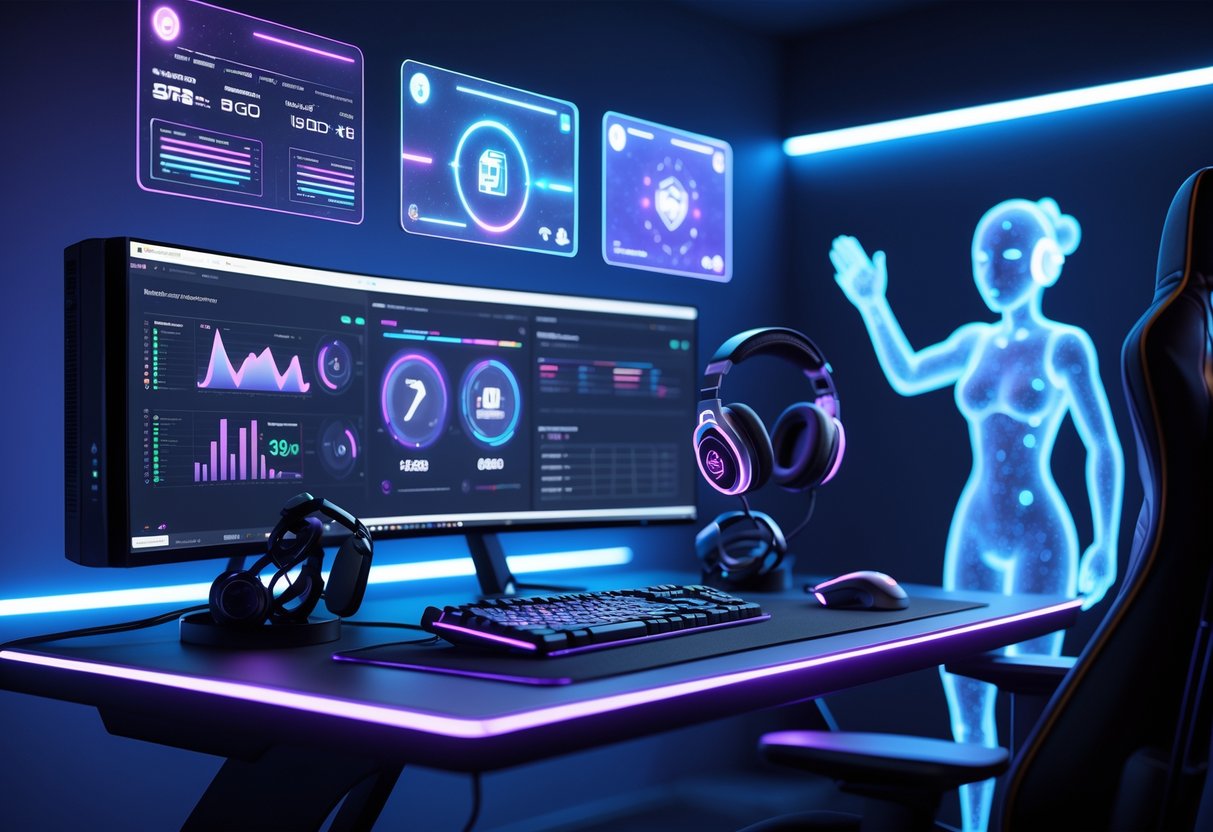
AI coaching tools can seriously boost your performance with real-time analysis, personalized feedback, and strategy tips that actually fit your playstyle. They use machine learning to track progress, spot weaknesses, and offer advice you can use right away.
How can artificial intelligence improve my gaming strategy?
AI looks at thousands of games to spot things you might miss. It tracks your choices in matches and compares them to what pros do.
Tools like Mobalytics break down your champion picks, positioning, and timing, especially in games like League of Legends. You’ll get advice like “work on last-hitting minions” or “pay more attention to the minimap in mid-game.”
AI coaching platforms also pick up on mistakes you keep making. For example, they might notice you always overextend in teamfights or trade badly in lane.
The best part? You get strategy tips that match your own style and skill level, not just generic advice.
What are the best AI-driven training programmes for competitive gamers?
SenpAI offers deep coaching for £7.99 a month. You get real-time match analysis and training plans for several games.
Mobalytics is super popular and has both free and paid versions. Their GPI (Gamer Performance Index) breaks your play down into things like aggression, teamfighting, and vision.
GameBit AI Coach focuses on esports training with real-time analytics and strategy help. They’re all about optimizing your performance.
A lot of semi-pros actually mix and match these tools instead of sticking with just one. That way, you cover more ground.
Could you recommend ways to track my progress with an AI gaming coach?
Most AI coaching tools come with dashboards that show your progress. You’ll see metrics like win rate, KDA, and skill scores over time.
Set weekly goals based on your coach’s advice. If it says you need better farming, try to bump up your CS per minute each week.
Many platforms give you replay analysis. You can compare old and new games to see if you’re positioning better or making smarter choices.
Take screenshots of your key stats every week. It’s motivating to see real improvement, especially when things get tough.
Are there AI tools that can analyse my playstyle and provide personalised tips?
Definitely. Several AI tools are built for playstyle analysis and personalized tips. Mobalytics, for example, creates profiles that show if you’re aggressive, passive, or somewhere in between.
You’ll get advice that matches your natural tendencies. If you’re aggressive, it might help you pick better moments to engage instead of trying to change your style.
SenpAI digs into your in-game decisions in real time. It suggests tweaks that work with how you already play.
These personalized tips usually work way better than generic guides. The AI learns from your history and gets more accurate over time.
In what ways can AI enhance my decision-making skills in fast-paced games?
AI coaching tools help you improve decisions by pointing out key moments in your replays. They flag those split-second choices that could have turned a fight or secured an objective.
Some tools give you real-time audio cues during games. They’ll remind you about timers, tell you when to back off, or point out bad positioning as it happens.
A lot of platforms offer scenario training. The AI throws common situations at you so you can practice reacting before you try it in ranked.
Pattern recognition is the big win here. AI spots the situations where you struggle, then gives you alternatives to practice and improve.
What’s the most effective way to incorporate AI tools into my daily gaming practice?
Kick off each gaming session by checking out what your AI coach suggested last time. Take a few minutes—maybe five or ten—to really think about the main things you should work on in your next games.
After every couple of ranked matches, run an AI analysis. Don’t wait until you’ve finished your whole session. This way, you get feedback right when the games are still fresh in your mind, and you can actually tweak your playstyle on the fly.
Set clear daily goals from your AI coach’s tips. Forget vague stuff like “just play better.” Try something you can actually measure, like “keep my CS over 7 per minute” or “make sure I place at least three wards each game.”
A lot of top players spend about 15 to 20 minutes every day going over AI-generated insights. Honestly, this kind of steady, short review helps you improve way faster than just sitting down for a marathon session once in a while.
